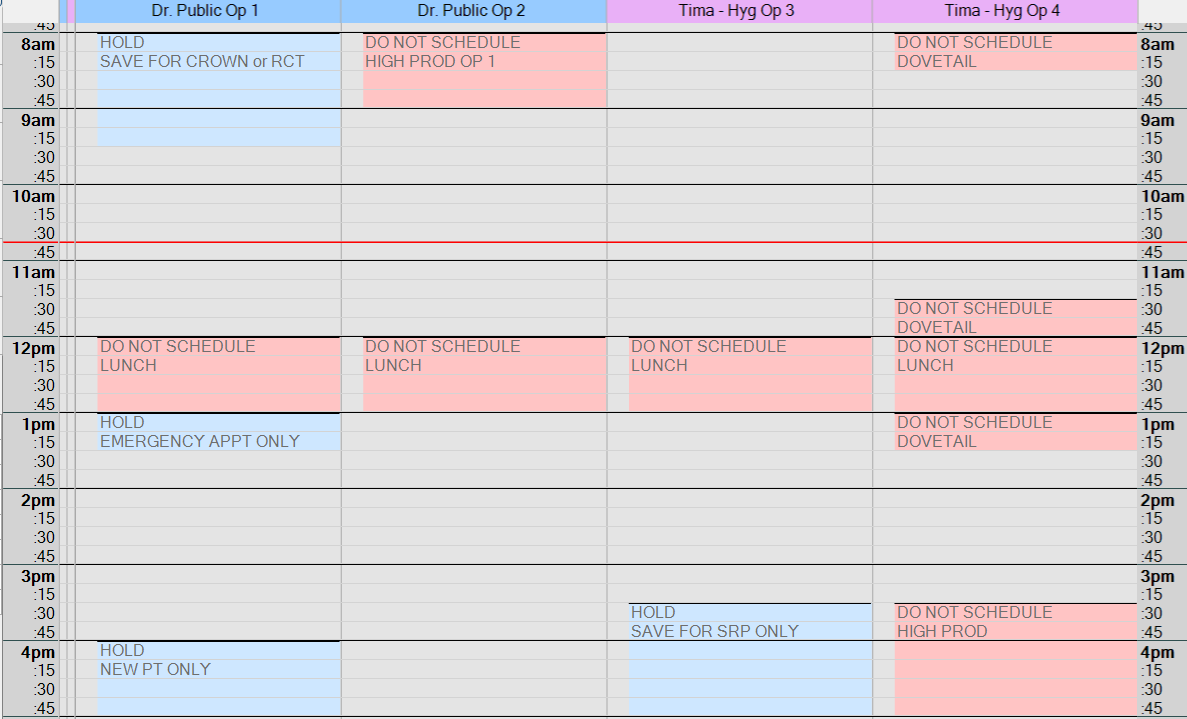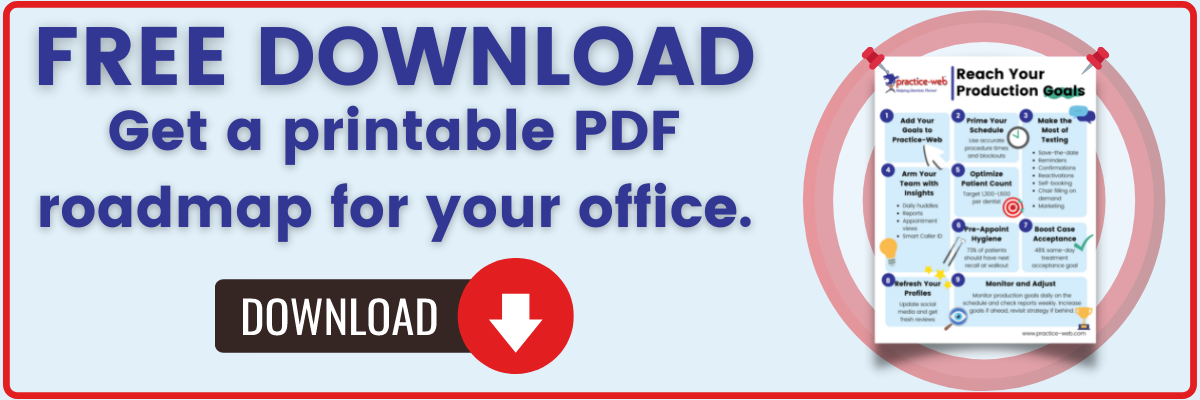Got big production goals? Setting targets for your dental practice is one of the most impactful things you can do to boost overall revenue. Just writing them down makes you 42 percent more likely to reach them, Inc. researchers say.
But, in a dental office, hitting targets is always a shared endeavor. Everyone needs to know the production goals and contribute in their own way to ensure the practice meets them. Below, we’ll go over some of the best ways to communicate targets and proven techniques that make it easy for everyone to contribute. Best of all, these strategies help you automate processes, so they fit into your natural workflows, boost efficiency, and can improve morale too. Let’s take a look.
1. Add Your Production Goals to Practice-Web
Remember how just writing production goals down can help you reach them? There’s a digital equivalent of this: adding them to Practice-Web. When you add your targets to your practice management software, everyone can see them and assess how close you are to meeting them. This alone is a powerful subconscious motivator, plus your team will be empowered to schedule accordingly too.
Production goals appear in all kinds of places, such as in the Daily Goal, seen in the Appointment Module below the calendar, and on reports. There are two simple steps to make this happen.
First, make sure each provider is scheduled in the system properly. To do this, you’ll go to Setup in Practice-Web, then choose Schedule.
Then, you’ll add each provider’s hourly production goal to Practice-Web. To do this, you’ll choose Lists in the main menu, select Providers, and then choose the provider you wish to edit. The space for an hourly production goal is near the bottom. Repeat this step for each provider.
2. Create Your Ideal Schedule
Set up your days to maximize production by ensuring appointments are automatically created at the right length and hold time for your high-production appointments with blockouts.
Appointment Lengths
When appointments are automatically set for the right length, anyone can create appointments and there will be no wasted time or bottlenecks on the schedule. Hopefully, your software is already set up to match your actual times. If not, or you do but you always seem to be running off schedule, time procedures to see how long they take and adjust the automatic scheduling time by editing the Procedure. To do this, you’ll choose Lists, then Procedure Codes, and then select the procedure in question.
This setting allows you to account for provider and assistant time individually as well. It’s worth setting this up for your practice because then anyone can look at the schedule and gauge when the doctor is free and if another procedure can be added.
Blockouts
Blockouts allow you to stack the deck to ensure you meet production goals on any given day. Consider how many high-production procedures the dentist must do to meet daily production goals, then add the appropriate blockouts.
For example, let’s say the dentist’s production goal is $300 per hour. In an eight-hour day, he or she would need to produce $2,400. If crowns are $1,000 each and your average filling cost is $200, the dentist would meet production by completing seven fillings and one crown. That means you’d need to create a blockout for one crown each day.

You can also use blockouts to denote:
- Time reserved for emergencies
- New patient exams
- Scaling and root planing
- And more
3. Arm Your Team with Insights
Each person on your team plays a role in helping you meet your production goals, but they may not know what their role is or how they influence it. Giving them access to critical data at the right moments can help.
Data-Driven Daily Huddles
When you make data the focus of your huddle, production increases by 30 percent according to Dental Intel. Use your huddle to go over the schedule, how close you are to meeting production goals, and what steps each person can take to ensure you get there.
Appointment Views and Patient Dashboards
Consider displaying key information on the patient dashboard, such as treatment and recall needs. That way, they jump out at you when you’re viewing a patient and you can schedule any additional procedures needed.
Similarly, you can choose the information you see on an appointment by setting up custom Appointment Views too. In this case, you may want the appointment to display if the patient is overdue for a recall appointment or show production information for the appointment.
Smart Caller ID
Ever have a patient call to pay a bill, hang up, and then realize you should have scheduled their overdue recall? Or maybe they called to schedule a recall and you missed that they still had a filling to do? It’s little things like this that happen in a fraction of a second that can either make or break your production… and even the best team member is going to miss them sometimes if they have to look for the info manually. That’s where Smart Tools like Smart Caller ID come in. It automatically gathers data and pops it up on the screen when an incoming call arrives, so your team not only provides better service but seizes every production-boosting opportunity too.
4. Optimize Your Patient Counts
It’s generally accepted that a single dentist needs 1,300 to 1,600 patients to sustain the practice. Some consultants draw a hard line at 1,500, saying you cannibalize production and don’t earn more if you go higher, while others say the max is as high as 2,300 per dentist.
If you’re below your optimal level, you need to attract new patients to meet your production goals.
If you’re at your optimal level, you can slow down on attracting new patients and focus on maximizing production from current patients.
5. Pre-Appoint
The top ten percent of practices typically pre-appoint at least 65 percent of their hygiene patients—up to 73 percent before COVID. That means when a patient leaves their office, they have the next recall appointment scheduled. The bottom 10 percent only pre-appointed about a quarter of patients in the last reporting year per Dental Intel.
Pre-appointing works simply because it takes effort to cancel an appointment, so most people just come. It’s a passive effort at that point. With a good reminder and confirmation system in place, anyone who might not otherwise make the appointment has to talk to your team, which means you can get them back on the schedule in the same conversation instead of hunting them down or playing phone tag.

6. Make the Most of Texting
Texting is an easy way to fill your chairs and keep them full. Most patients prefer it, and it has an ultra-fast response time—95 percent of texts are responded to within three minutes. You can use a patient texting tool to send:
- Save-the-date texts that make it easy for patients to add appointments to their digital calendars
- Appointment reminders to increase bookings and minimize last-minute cancellations
- Confirmation texts to eliminate no-shows from forgotten appointments (and save your team time through automated confirmation logging)
- Invitations to self-book that include a link to your Online Scheduling portal (and free your team from manual booking)
- Chair-filling texts that work with your Lists (ASAP, Unscheduled, etc.) and encourage patients to appoint
- Reactivation notices sent to patients to get them active again
- Mass marketing messages that let patients know about practice specials
7. Boost Case Acceptance
Naturally, patients need to accept their treatment plans for the dentist to stay busy. The top ten percent of practices have an average same-day treatment acceptance rate of 48 percent, compared to 15 percent in the bottom ten percent according to Dental Intel.
A few tips that can help:
- Avoid “gimmicks” and focus on education.
- Use x-rays, images, perio charting, and models to demonstrate concerns.
- Give patients all their options, so they feel empowered to take action.
- Consider offering patient payment plans or exploring ways to help patients fit their dental needs into their budgets.
8. Refresh Your Social Media and Review Profiles
If you’re treating your existing patients well, they’ll often help you spread the word about your practice. Take a look at all your online profiles, including social media networks and review websites to ensure everything is up to date and looks fresh. When it comes to review sites, you may also want to invest in a tool that automatically asks patients to leave reviews after their appointment. This is an important step because almost 90 percent of prospective patients read reviews before they’ll book with you and they not only want to read several but will consider the recency of reviews too.
9. Monitor Your Results and Adjust Targets Accordingly
Because Practice-Web keeps scheduled production and production goals right on your schedule, there should be no surprises at all whether you’re on track to meet your goals in the long run too. However, it’s still best practice to monitor your progress and see how you’re doing. Run a production goals report in Practice-Web each week and quarter.
If you’re soaring past your production goals, it may be time to bump them up a bit. If you’re missing the mark, circle back to the tips outlined here to see where you can improve.
Get Help Reaching Your Production Goals
Not using Practice-Web, but think it might help your practice reach new heights? We’d love to walk you through the software in a complimentary demo. Click here to request one.
Already using Practice-Web and need help implementing one of the strategies here or want to sign up for one of the production-boosting tools we mentioned? Click here to send us a message.

